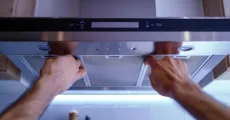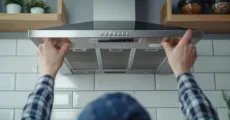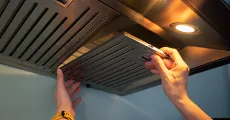Fixes for Common Vent | Issues in Range Hoods

Range hood vent issues can disrupt your kitchen’s comfort and functionality, but many common problems are easy to identify and fix. Symptoms like a fan not spinning, unusual noises, weak suction, or inconsistent speeds often point to issues with the motor, fan blades, or filters. Detailed fixes include cleaning grease buildup, tightening loose components, and replacing faulty motors or switches. Regular maintenance, such as cleaning filters and inspecting ductwork, can prevent these problems.
Fixes for Common Vent Issues in Range Hoods
Your range hood is more than a luxury but it’s a necessity for maintaining a clean and comfortable kitchen. It ensures proper ventilation by eliminating smoke, grease, and odors while keeping air quality high. However, when it malfunctions, your kitchen can quickly become a frustrating space to cook. Issues like weak suction, noisy operation, or an unresponsive motor can disrupt your kitchen’s functionality and affect your home’s atmosphere. In this guide, we’ll explore the most common range hood vent issues, how to diagnose them, and step-by-step solutions to keep your system running smoothly. Remember, for complex problems, professional service is the long-term solution.
Your fridge is a kitchen superstar as it keeps all your food fresh and drinks cold.
But does the fridge feel warm when you open it?
Is there water all over the floor?
Fridge issues are the worst!
Symptoms of Range Hood Vent Problems
Recognizing early symptoms of a malfunctioning range hood can prevent minor issues from escalating into costly repairs. Common symptoms include:
- Fan Not Spinning: When the fan stops spinning, your range hood cannot circulate air, leading to a stuffy kitchen environment.
- Unusual Noises: Strange sounds like rattling, grinding, or humming can indicate mechanical issues, loose screws, or debris stuck in the fan.
- Weak Suction: Reduced airflow may result from clogged filters, blocked ductwork, or an underpowered motor.
- Inconsistent Fan Speeds: If your fan speeds fluctuate or do not adjust as expected, this could point to faulty wiring or a failing motor.
Each of these symptoms provides clues to the underlying issue, helping you determine whether a DIY fix is possible or if professional assistance is needed.
Common Issues and Detailed Fixes
1. Motor Not Spinning
- Cause: Accumulated grease, mechanical wear, or electrical failure.
- Fix:
- Clean the Fan Blades: Built-up grease can jam the motor. Use a degreasing cleaner and a soft brush to scrub the blades and housing.
- Tighten Loose Screws: Loose screws in the motor assembly can disrupt functionality. Ensure all components are securely fastened.
- Replace the Motor: If cleaning and tightening fail, the motor might be burned out. Disconnect the power supply, remove the motor, and replace it with a compatible model based on your range hood specifications.
2. Noisy Operation
- Cause: Debris, misaligned components, or worn-out bearings.
- Fix:
- Lubricate Bearings: Noise from the motor bearings can often be reduced with lubrication. Apply a small amount of machine oil to accessible areas.
- Secure Loose Components: Check for any loose screws or brackets that might cause vibrations.
- Clear Debris: Debris caught in the fan blades can result in rattling noises. Remove obstructions carefully.
- Replace Damaged Blades: If the fan blades are bent or cracked, replace them to restore smooth operation.
3. Weak Suction
- Cause: Blocked filters, clogged ducts, or an incompatible motor.
- Fix:
- Replace Filters: Wash reusable filters with warm soapy water or replace disposable ones.
- Clean Ductwork: Accumulated grease or obstructions in the ductwork can limit airflow. Inspect the ducts and clean them thoroughly.
- Adjust Fan Speed: Test the speed control to ensure the fan operates at its intended capacity. Replace faulty switches as needed.
4. Inconsistent Fan Speeds
- Cause: Faulty wiring, damaged switches, or motor wear.
- Fix:
- Check Electrical Connections: Loose or damaged wires can lead to irregular fan speeds. Secure all connections.
- Replace the Switch: Test the fan speed control switch using a multimeter and replace it if necessary.
- Inspect the Motor: Persistent speed fluctuations may indicate a failing motor that needs replacement.
How to Diagnose Range Hood Vent Problems
Diagnosing issues with your range hood is a systematic process. Follow these steps:
- Check the Power Supply: Ensure the hood is securely plugged in. Test the outlet with another device and inspect the circuit breaker for tripped switches.
- Inspect the Fan Switch: Use a multimeter to check the continuity of the fan switch. Faulty switches can prevent power from reaching the motor.
- Examine the Motor: Look for physical damage, overheating, or loose connections. Pay attention to unusual sounds when the motor is running.
- Test Motor Functionality: Unplug the hood and manually spin the fan blades to detect obstructions or resistance. Use a multimeter to verify the motor is receiving adequate voltage.
DIY Maintenance and Preventive Tips
Regular maintenance is key to avoiding range hood issues. Implement these practices to ensure longevity:
- Clean Filters Monthly: Filters clogged with grease can reduce airflow. Wash reusable filters and replace disposable ones regularly.
- Inspect Fan Blades: During routine cleaning, check for grease buildup and misaligned blades.
- Check Ductwork: Ensure ducts are free of obstructions to maintain efficient airflow.
- Tighten Screws: Vibrations can loosen screws over time. Inspect and secure all fasteners during cleaning.
- Schedule Annual Professional Maintenance: A professional inspection can uncover hidden issues and keep your range hood performing at its best.
Routine upkeep not only prevents breakdowns but also ensures your kitchen remains a safe and pleasant environment.
Noisy Operation
Loud noises can be caused by dirty coils making the compressor work harder or the temperature is set too low. Clean the coils and adjust the temperature setting to the recommended range. Persistent noise may require professional repair.






When to Call a Professional
Certain range hood problems require specialized tools and expertise. Issues such as persistent electrical failures, motor replacements, or ductwork repairs are best handled by professionals. Attempting complex range hood repair without adequate knowledge can lead to further damage or safety hazards.
CLT Appliance Repair offers reliable, efficient, and affordable solutions for all your range hood concerns. With our expert technicians, you can rest assured that your kitchen ventilation system will be restored to peak performance. Don’t risk the hassle reach out to us today and experience peace of mind.
FAQs
A loud humming sound usually indicates motor strain caused by grease buildup or a failing capacitor. Clean the motor and fan blades, and replace damaged components.
To improve airflow, clean or replace clogged filters, inspect the ductwork for blockages, and ensure the motor is operating efficiently.
Replacing a motor requires electrical knowledge and attention to detail. If you’re unsure, it’s safer to contact a professional for assistance.
Clean the filters monthly and deep clean the fan blades and ducts every six months to maintain optimal performance.
Check the power supply, outlet, and circuit breaker. If these are working, the problem may lie in the motor or control switch, which should be inspected by a professional.
Don't let a malfunctioning Range Hood disrupt your daily life. Contact CLT Appliance Repair today at 704-606-9043 to schedule your Range Hood repair service.
We'll have your Range Hood back to optimal performance in no time!.

